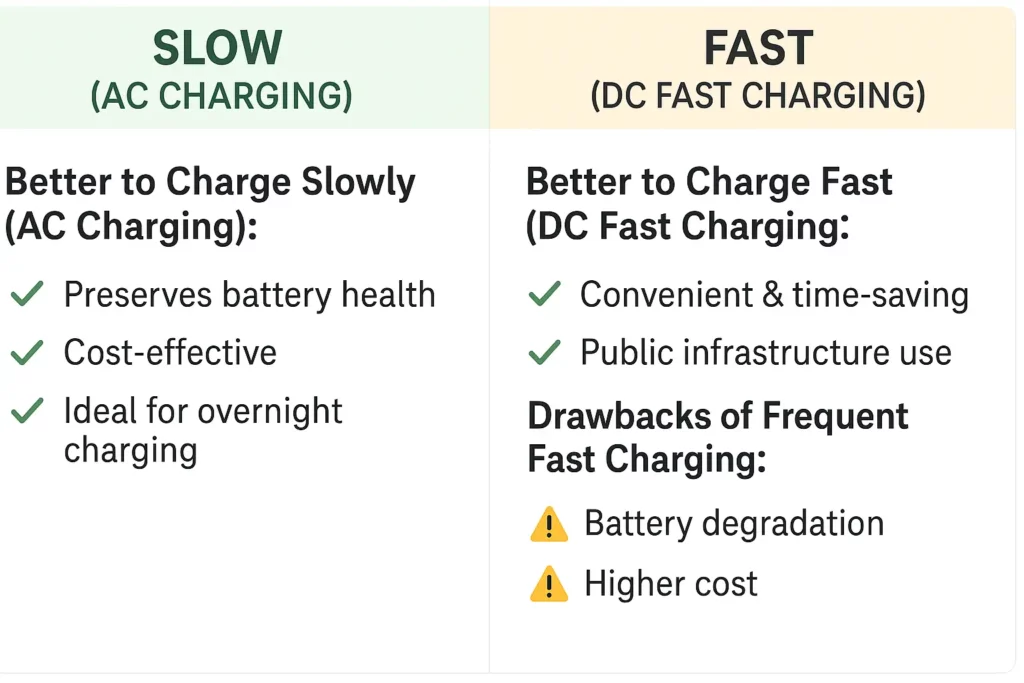Introduction
As electric vehicles (EVs) become more popular, many drivers face the question: should you charge your EV fast or slow? While fast charging is undeniably convenient, slow charging offers benefits for battery longevity and cost savings. This blog breaks down the pros and cons of each method to help you make an informed decision.
What Are the Different EV Charging Levels?

1.Level 1(slow charging)
Power Output: 2.3–7.4 kW (typically 3.6 kW or 7.2 kW)
Connector Types: Type 1, Type 2
Charging Time:
3.6 kW: ~6–12 hours for a full charge (depending on battery size)
7.2 kW: ~4–8 hours
Typical Use:
Home charging (overnight)
Workplace charging
Pros: Gentle on battery, cost-effective
Cons: Too slow for road trips or time-sensitive use
2.Level 2(fast charging, ACand DC)
Power Output: 7.4–22 kW (AC) or up to 50 kW (DC)
Connector Types:
AC: Type 2 (Europe), J1772 (USA)
DC: CCS or CHAdeMO (DC fast chargers)
Charging Time:
22 kW AC: ~2–4 hours
50 kW DC: ~1–2 hours to 80%
Typical Use:
Public chargers (parking lots, shopping centers)
Pros: Faster turnaround
Cons: Slightly higher cost, moderate heat impact on battery
3.Rapid Charging (DC Fast Charging)
Power Output:
50–150 kW = “Rapid”
150–350 kW = “Ultra-Rapid” or “High-Power Charging (HPC)”
Connector Types: CCS (most common), CHAdeMO (older systems)
Charging Time:
50 kW: 80% in 30–60 mins
150–350 kW: 80% in 15–30 mins (if vehicle supports it)
Typical Use:
Highway rest stops, long-distance travel
Pros: Extremely fast
Cons: Expensive, more battery stress, not all EVs support high-power charging
How Charging Speed Affects Battery Health
Frequent use of DC fast charging can degrade the battery more quickly due to heat and higher current loads. The rapid influx of energy creates thermal stress, especially if the vehicle doesn’t have advanced cooling systems. In contrast, slow or Level 2 charging is gentler and generates less heat, extending battery life over the long term.
Cost Comparison: Fast vs. Slow Charging
Slow charging—especially at home during off-peak hours—is often the most economical option. Fast chargers at public stations, particularly DC fast chargers, are more expensive per kilowatt-hour and may include idle fees. Over time, home charging can significantly reduce your EV’s total cost of ownership.
When Should You Use Fast Charging?

Fast charging is best reserved for:
Long-distance trips
Emergency situations
When you have limited time
Not all EVs support high-speed charging, and some may limit the charging rate to preserve battery health. Always check your EV’s specifications before relying on fast chargers.
Is Slow Charging Better for Daily Use?

Yes. For most EV drivers, slow or Level 2 charging at home or work is ideal for daily needs. It allows you to charge overnight when electricity rates are lower, and it helps maintain battery health over time.
Energy Efficiency and Environmental Considerations
Fast charging can put more strain on the electrical grid and may be less energy-efficient due to conversion losses and thermal management. Slow charging tends to be more stable and can integrate better with renewable energy sources like solar, reducing your overall carbon footprint.
Tips to Extend EV Battery Life Regardless of Charging Speed
Avoid charging to 100% regularly unless needed for range
Don’t let the battery drop below 10% frequently
Use scheduled or smart charging features
Keep your battery cool—avoid charging immediately after driving
Conclusion
While fast charging offers unmatched convenience, it’s not always the best choice for daily use. Slow or Level 2 charging is better for battery longevity, energy efficiency, and overall cost savings. A balanced approach—using fast charging when necessary and slow charging routinely—will keep your EV running efficiently for years.







